You could try using kmeans, which is part of baseR. Here is a simple code which will target 3 centers:
result <- kmeans(df, 3)
> result
K-means clustering with 3 clusters of sizes 4, 1, 1
Cluster means:
lat lng
1 17.49140 78.39838
2 17.47077 78.35874
3 17.51965 78.37835
Clustering vector:
[1] 1 1 3 1 1 2

Keep in mind that there is no guarantee that your data may fit well with kmeans and 3 centers. This run of kmeans led to 4 observations ending up in one cluster, with the other 2 clusters having only 1 observation. If you are unhappy with this run, you can play around a bit until you can converge on something which fits well.
Here is a link to a tutorial which might help.
